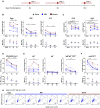Prolonged evolution of the human B cell response to SARS-CoV-2 infection
- PMID: 33622975
- PMCID: PMC8128290
- DOI: 10.1126/sciimmunol.abg6916
Prolonged evolution of the human B cell response to SARS-CoV-2 infection
Abstract
A comprehensive understanding of the kinetics and evolution of the human B cell response to SARS-CoV-2 infection will facilitate the development of next-generation vaccines and therapies. Here, we longitudinally profiled this response in mild and severe COVID-19 patients over a period of five months. Serum neutralizing antibody (nAb) responses waned rapidly but spike (S)-specific IgG+ memory B cells (MBCs) remained stable or increased over time. Analysis of 1,213 monoclonal antibodies (mAbs) isolated from S-specific MBCs revealed a primarily de novo response that displayed increased somatic hypermutation, binding affinity, and neutralization potency over time, providing evidence for prolonged antibody affinity maturation. B cell immunodominance hierarchies were similar across donor repertoires and remained relatively stable as the immune response progressed. Cross-reactive B cell populations, likely re-called from prior endemic beta-coronavirus exposures, comprised a small but stable fraction of the repertoires and did not contribute to the neutralizing response. The neutralizing antibody response was dominated by public clonotypes that displayed significantly reduced activity against SARS-CoV-2 variants emerging in Brazil and South Africa that harbor mutations at positions 501, 484 and 417 in the S protein. Overall, the results provide insight into the dynamics, durability, and functional properties of the human B cell response to SARS-CoV-2 infection and have implications for the design of immunogens that preferentially stimulate protective B cell responses.
Copyright © 2021, American Association for the Advancement of Science.
Figures




Similar articles
-
Profiling B cell immunodominance after SARS-CoV-2 infection reveals antibody evolution to non-neutralizing viral targets.Immunity. 2021 Jun 8;54(6):1290-1303.e7. doi: 10.1016/j.immuni.2021.05.001. Epub 2021 May 6. Immunity. 2021. PMID: 34022127 Free PMC article.
-
Clinical course impacts early kinetics,magnitude, and amplitude of SARS-CoV-2 neutralizing antibodies beyond 1 year after infection.Cell Rep Med. 2022 Jan 24;3(2):100523. doi: 10.1016/j.xcrm.2022.100523. eCollection 2022 Feb 15. Cell Rep Med. 2022. PMID: 35233547 Free PMC article.
-
Sequential Analysis of Binding and Neutralizing Antibody in COVID-19 Convalescent Patients at 14 Months After SARS-CoV-2 Infection.Front Immunol. 2021 Nov 26;12:793953. doi: 10.3389/fimmu.2021.793953. eCollection 2021. Front Immunol. 2021. PMID: 34899762 Free PMC article.
-
The comprehensive insights into the B-cells-mediated immune response against COVID-19 infection amid the ongoing evolution of SARS-CoV-2.Biomed Pharmacother. 2025 Apr;185:117936. doi: 10.1016/j.biopha.2025.117936. Epub 2025 Mar 8. Biomed Pharmacother. 2025. PMID: 40056829 Review.
-
Monoclonal Antibody Generation Using Single B Cell Screening for Treating Infectious Diseases.BioDrugs. 2024 Jul;38(4):477-486. doi: 10.1007/s40259-024-00667-0. Epub 2024 Jul 2. BioDrugs. 2024. PMID: 38954386 Free PMC article. Review.
Cited by
-
Bamlanivimab therapy for acute COVID-19 does not blunt SARS-CoV-2-specific memory T cell responses.JCI Insight. 2022 Dec 22;7(24):e163471. doi: 10.1172/jci.insight.163471. JCI Insight. 2022. PMID: 36378539 Free PMC article.
-
Isolation of human monoclonal antibodies with neutralizing activity to a broad spectrum of SARS-CoV-2 viruses including the Omicron variants.Antiviral Res. 2022 May;201:105297. doi: 10.1016/j.antiviral.2022.105297. Epub 2022 Mar 24. Antiviral Res. 2022. PMID: 35341809 Free PMC article.
-
Longitudinal Systemic and Mucosal Immune Responses to SARS-CoV-2 Infection.J Infect Dis. 2022 Sep 28;226(7):1204-1214. doi: 10.1093/infdis/jiac065. J Infect Dis. 2022. PMID: 35188974 Free PMC article.
-
Immunopathology and Immunosenescence, the Immunological Key Words of Severe COVID-19. Is There a Role for Stem Cell Transplantation?Front Cell Dev Biol. 2021 Sep 14;9:725606. doi: 10.3389/fcell.2021.725606. eCollection 2021. Front Cell Dev Biol. 2021. PMID: 34595175 Free PMC article. Review.
-
Structural Immunology of SARS-CoV-2.Immunol Rev. 2025 Jan;329(1):e13431. doi: 10.1111/imr.13431. Epub 2024 Dec 27. Immunol Rev. 2025. PMID: 39731211 Free PMC article. Review.
References
-
- Andreano E., Piccini G., Licastro D., Casalino L., Johnson N. V., Paciello I., Monego S. D., Pantano E., Manganaro N., Manenti A., Manna R., Casa E., Hyseni I., Benincasa L., Montomoli E., Amaro R. E., McLellan J. S., Rappuoli R., SARS-CoV-2 escape in vitro from a highly neutralizing COVID-19 convalescent plasma. bioRxiv 2020.2012.2028.424451 (2020). - PMC - PubMed
-
- Kemp S. A., Collier D. A., Datir R., Ferreira I., Gayed S., Jahun A., Hosmillo M., Rees-Spear C., Mlcochova P., Lumb I. U., Roberts D. J., Chandra A., Temperton N., Sharrocks K., Blane E., Briggs J., van Gils M. J., Smith K., Bradley J. R., Smith C., Doffinger R., Ceron-Gutierrez L., Barcenas-Morales G., Pollock D. D., Goldstein R. A., Smielewska A., Skittrall J. P., Gouliouris T., Goodfellow I. G., Gkrania-Klotsas E., Illingworth C., McCoy L. E., Gupta R. K., Neutralising antibodies in Spike mediated SARS-CoV-2 adaptation. medRxiv 2020.2012.2005.20241927 (2020). - PubMed
-
- Wang P., Liu L., Iketani S., Luo Y., Guo Y., Wang M., Yu J., Zhang B., Kwong P. D., Graham B. S., Mascola J. R., Chang J. Y., Yin M. T., Sobieszczyk M., Kyratsous C. A., Shapiro L., Sheng Z., Nair M. S., Huang Y., Ho D. D., Increased Resistance of SARS-CoV-2 Variants B.1.351 and B.1.1.7 to Antibody Neutralization. bioRxiv 2021.2001.2025.428137 (2021). - PubMed
Publication types
MeSH terms
Substances
Grants and funding
LinkOut - more resources
Full Text Sources
Other Literature Sources
Medical
Miscellaneous

